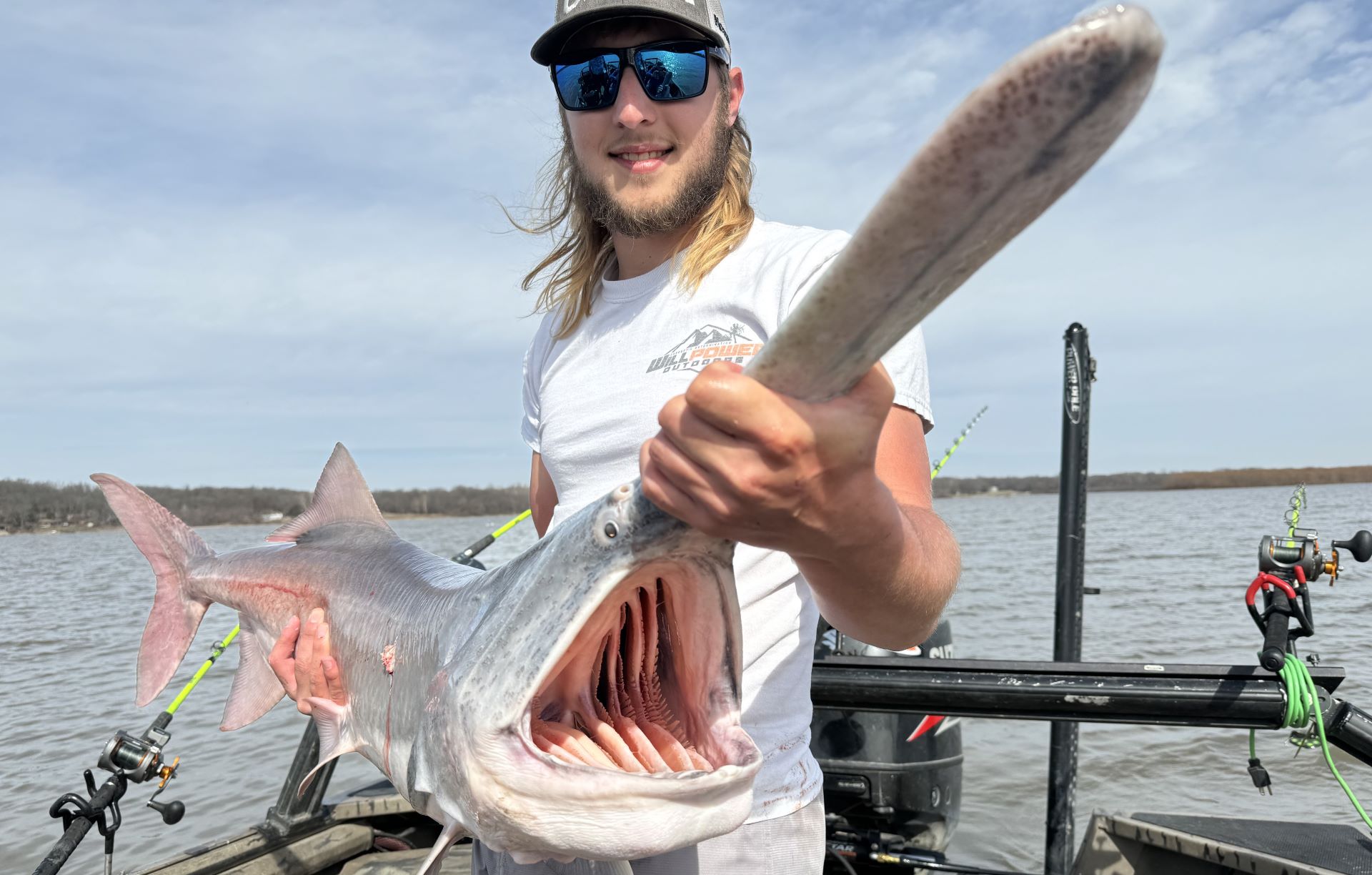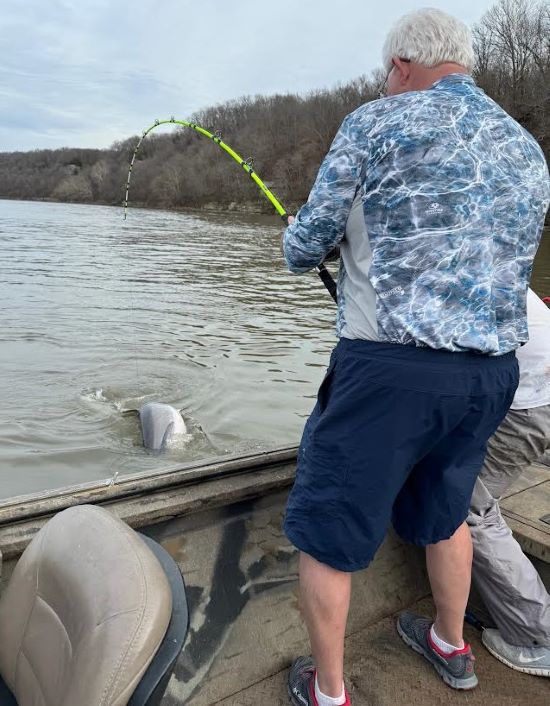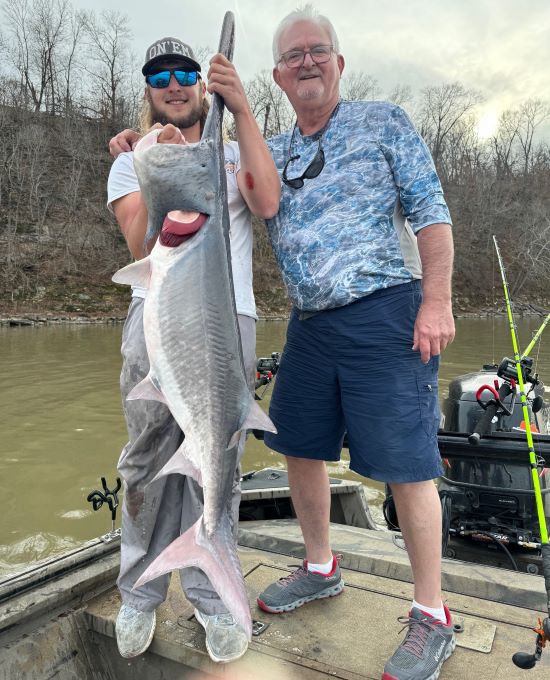‘Dinosaur’ Fish Season Begins in Missouri Spring Anglers Seek to Snag Massive Paddlefish
 Haydn Williams, a guide on Grand Lake O' the Cherokees, displays the carrier of spring fever – a paddlefish. (Brent Frazee | Flatland)
Haydn Williams, a guide on Grand Lake O' the Cherokees, displays the carrier of spring fever – a paddlefish. (Brent Frazee | Flatland)
Published March 15th, 2024 at 6:00 AM
“We’re going after the biggest fish in the lake.”
Guide Haydn Williams uttered those words matter-of-factly as he pulled his boat onto the Neosho River, a tributary of Grand Lake O’ the Cherokees in Oklahoma.
Hype? No. He wasn’t exaggerating. We were hunting dinosaurs — paddlefish, the prehistoric fish that can grow to more than 100 pounds.
River monsters lurked below. It was just a matter of running the giant hooks across the right fish at the right time, he said.
You don’t exactly “fish” for paddlefish. You leave the bait buckets and tackle boxes at home. Paddlefish don’t get monstrous by eating typical forage. They get that size by eating — get this — plankton.
That’s why anglers sweep huge hooks through the water in hopes of snagging one.
It’s a year-long pursuit at Grand Lake. But at no time are the chances better than in the spring when the paddlefish leave the main lake and make their spawning run up the Neosho.
It’s a rite of spring to go paddlefish snagging, not only in Oklahoma but in Missouri as well.
At reservoirs such as Grand and Keystone in Oklahoma and Lake of the Ozarks, Truman and Table Rock in Missouri, spring fever is spread by potbellied paddlefish.
“The biggest fish we’ve caught weighed 102 pounds,” said the 23-year-old Williams. “That was in late January a few years ago. That fish was in 60 feet of water on the main lake.
“It’s easier when they move up the Neosho to spawn. We’re in only 30 feet of water. But you still have to find them.”
Williams had electronics on his boat to help in that pursuit. Two large screens in front of him showed what was going on below. He pointed at elongated marks that clearly showed the paddle-like nose that is the fish’s namesake.
“They’re in here,” Williams said. “Once the water temperature hits 50 (degrees), they left the main lake and were in the river in a day and a half.”
Snagging Fish
In the not-so-distant past, paddlefish snagging amounted to a back wrenching, exhausting pursuit.
Anglers would sweep big hooks and weights through the water, hoping to find the ultimate needle in a haystack.
Some anglers, especially those who fish from the bank, still do that.
But guides such as Williams have simplified the process. They use electronics to find stretches of water with fish, then troll with weights called divers so that their hooks will stay at the desired depth.
Heavy-duty rods are placed in holders and anglers wait until the drag on the reels starts to burn.
That happened shortly after Williams dropped the lines on a recent weekday. One of the rods bent sharply and bounced in the holder. One of Williams’ clients, Greg Thompson of Liberty, Missouri, grabbed the rod and at once felt the power of a big paddlefish.

The fight was short-lived. When you’re using an 80-pound braided line, that’s often the case.
After Williams lifted the fish, he said: “That’s an average fish here. We’ll catch a lot of 30- to 50-pound fish.”
That fish was released, as were three others Thompson and I caught.
At Grand Lake, paddlefish snaggers are required to use barbless hooks and can practice catch-and-release.
If they want to keep fish, they are restricted to an annual harvest of two fish, only one per day.
There are plenty of fish to catch. The population is self-sustaining. Unlike some states, Missouri included, the Oklahoma Department of Wildlife Conservation doesn’t have to stock paddlefish to bolster the population.
“We have a lot of 40- to 50-pound fish, but it’s not uncommon to see some weighing 80 to 100 pounds,” said Brad Johnston, northeast regional fisheries supervisor for the Oklahoma Department of Wildlife Conservation.
And those giants that anglers mention in fish stories?
“We netted a 131-pounder during a survey in 2016,” Johnson said. “I wouldn’t be surprised to see a fish like that caught at Grand.”
Paddlefish Season in Missouri
Oklahoma is the king when it comes to paddlefish snagging. Several world records have been set at Keystone Lake in northeastern Oklahoma (the latest weighed 164 pounds).
But Missouri has outstanding fishing, too.
Though major reservoirs and their tributaries are reliant on annual stocking by the Missouri Department of Conservation, fish grow to huge proportions.

The Missouri state record is 140 pounds, 10 ounces, caught at Lake of the Ozarks in 2022.
But huge fish also roam Table Rock and Truman Lake. The previous Missouri record, only one ounce less than the current standard, was caught at Table Rock.
Rick LaPoint, a veteran guide at Table Rock, knows that giant fish still head up the James River to spawn.
He and his son, Aaron, have both guided customers to fish weighing more than 100 pounds.
“They’ll run as far up the James River as Springfield,” LaPoint said. “The key is keeping up with how far they have gone.”
The Missouri paddlefish season annually opens March 15 and runs through April 30 for most of the major fisheries.
The opener is so popular that some anglers are on the water at 12:01 a.m. March 15 to greet the season.
“People down here just go crazy over the snagging season,” LaPoint said. “I think it’s the idea of catching a huge fish that gets them excited.”
Brent Frazee is an award-winning outdoors writer who lives in Parkville. He was outdoors editor of The Kansas City Star for 36 years before retiring in 2016.



A Kansas man caught a world record fish on March 17th in Lake of the Ozarks.